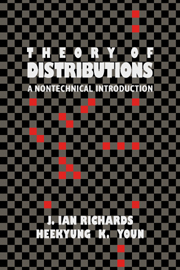Book contents
- Frontmatter
- Contents
- Preface
- 1 Introduction
- 2 The elements of distribution theory
- 3 Examples of distributions
- 4 Fourier transforms
- 5 Tempered distributions
- 6 Extension to higher dimensions
- 7 A general definition of multiplication and convolution for distributions
- Appendix 1 Partitions of unity
- Appendix 2 The Structure Theorem
- Appendix 3 Proof of Theorems A and B from Chapter 7
- Bibliography
- Index
4 - Fourier transforms
Published online by Cambridge University Press: 06 January 2010
- Frontmatter
- Contents
- Preface
- 1 Introduction
- 2 The elements of distribution theory
- 3 Examples of distributions
- 4 Fourier transforms
- 5 Tempered distributions
- 6 Extension to higher dimensions
- 7 A general definition of multiplication and convolution for distributions
- Appendix 1 Partitions of unity
- Appendix 2 The Structure Theorem
- Appendix 3 Proof of Theorems A and B from Chapter 7
- Bibliography
- Index
Summary
The theory of distributions achieves especial power when it is combined with the theory of Fourier transforms.
In accordance with the plan of this book, in which advanced calculus is to be the only prerequisite, we must develop the classical theory of Fourier transforms to the depth that we need it. Fortunately, this is not very far: almost all of the technical aspects of Fourier transform theory can be omitted. In fact, distribution theory provides a new approach to the whole subject – an achievement which may be the most beautiful and far reaching of all the applications of the distribution idea.
Nevertheless, there is a hard core of basic facts about the Fourier transform which we need before we can begin the distribution–theoretic treatment. Here these classical facts are laid out in a leisurely fashion, with a heavy stress on their physical motivation. The distribution–theoretic approach (which generalizes the theory to a surprising extent) is given in the next chapter.
The physical interpretation of complex numbers
There are many such interpretations, of course – physics is a rich subject – but the following is in some sense the clearest and most classical.
As an aside, we begin by ruling out something which is unsatisfactory. The interpretation of complex numbers as two-dimensional vectors is unsatisfying, because the curious mind asks: What about three-dimensional or n-dimensional vectors? Why such a fuss over two-dimensions? A purely mathematical answer is that the complex numbers are the only finitedimensional extension of the reals in which all of the laws of arithmetic hold [HR, chap. 7]. These laws, of course, involve addition, subtraction, multiplication and division.
- Type
- Chapter
- Information
- The Theory of DistributionsA Nontechnical Introduction, pp. 42 - 57Publisher: Cambridge University PressPrint publication year: 1990



